
Lighting 201 – The Ultimate Home Guide

- Published:
- Filed Under: Electrical, Fixit Academy
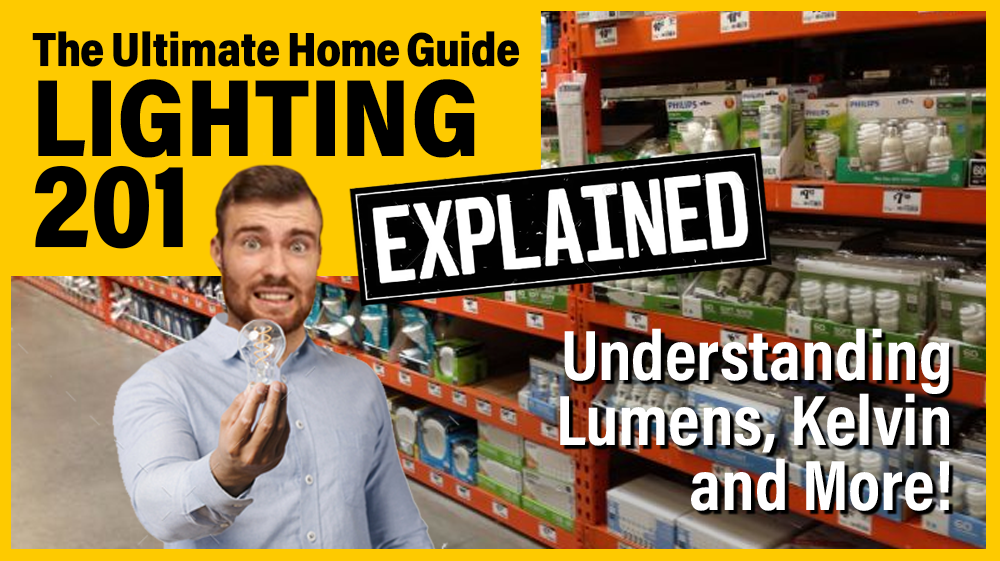
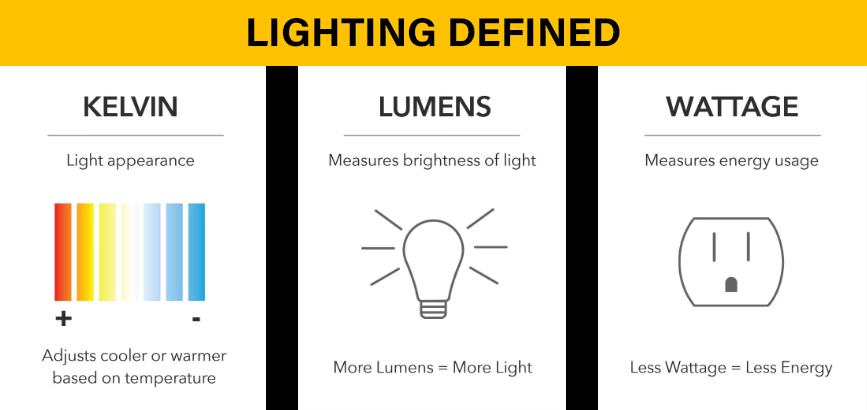
By now, most people probably know that the incandescent light bulbs that we grew up with cost more money and used more energy than their CFL and LED counterparts. But old habits are hard to break, and it is all too easy when walking through the supermarket aisles to grab a 4-pack of the cheapest bulbs on the shelf. Stores stock thousands of bulbs, including incandescent and halogen bulbs, CFL, Linear, and HID fluorescent bulbs as well as the latest technology with LED bulbs. Whether you’re using identical bulbs to replace those that have burned out or you’re upgrading to something more efficient.
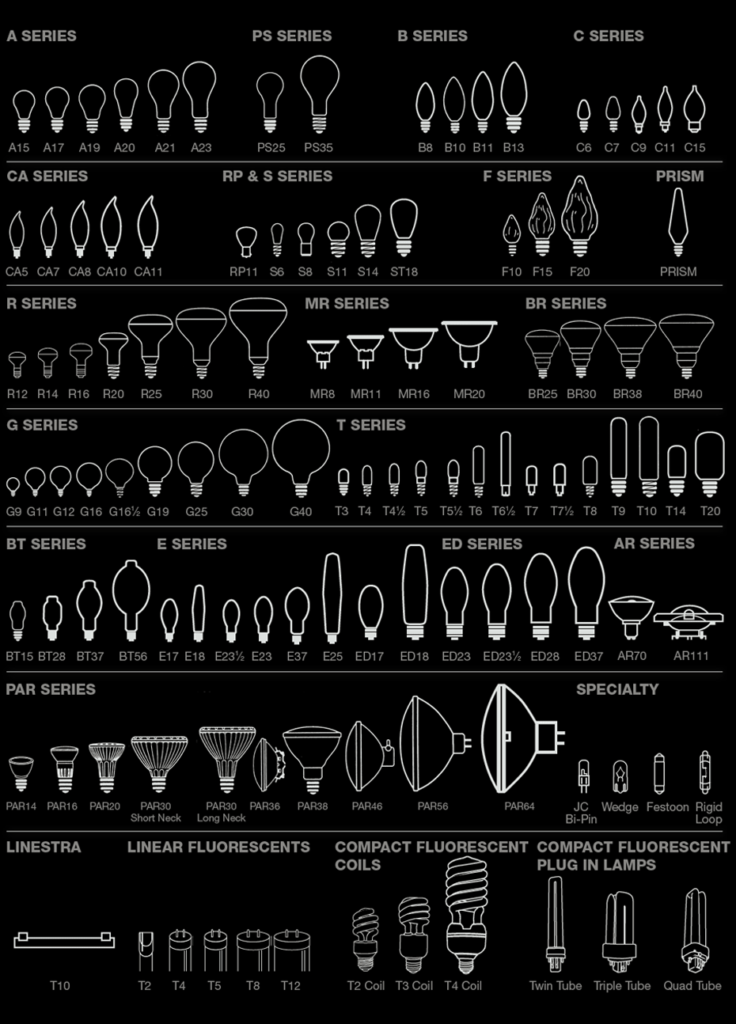
BULB BASES – Each lighting fixture has its own requirements of the light bulb base size and shape, and your bulb will work well only when it’s perfectly compatible with the fixture socket. In this case, whenever you go to purchase a new light bulb, firstly check out its package to learn about the bulb base size it has. And to help you actually know what light bulb base size you need for different situations and fixtures.
Edison screw bases are the most common base types, as they are also used in the most popular LED bulbs today. That’s why LED bulbs are a great alternative to traditional incandescent bulbs. The letter “E” stands for Edison screw-in style, after the great inventor, and the number for the base diameter. Among them, E26 base and E12 base are the most familiar bulb bases to us, which are also called medium base and candelabra base. Most Edison bases are single-contact bases, but a few are double-contact bases that add a “d” to the end, such as the E26d, which is commonly used for three-way bulbs.
By knowing the type and size of the bulb base, you can ensure that you get the right bulb you need. By the way, LED light bulb sockets and bases are manufactured to the same standards as halogen, incandescent, CFL and other traditional lights. Replacing your existing light bulbs with LEDs is a great option with lower energy consumption and more environmental protection.
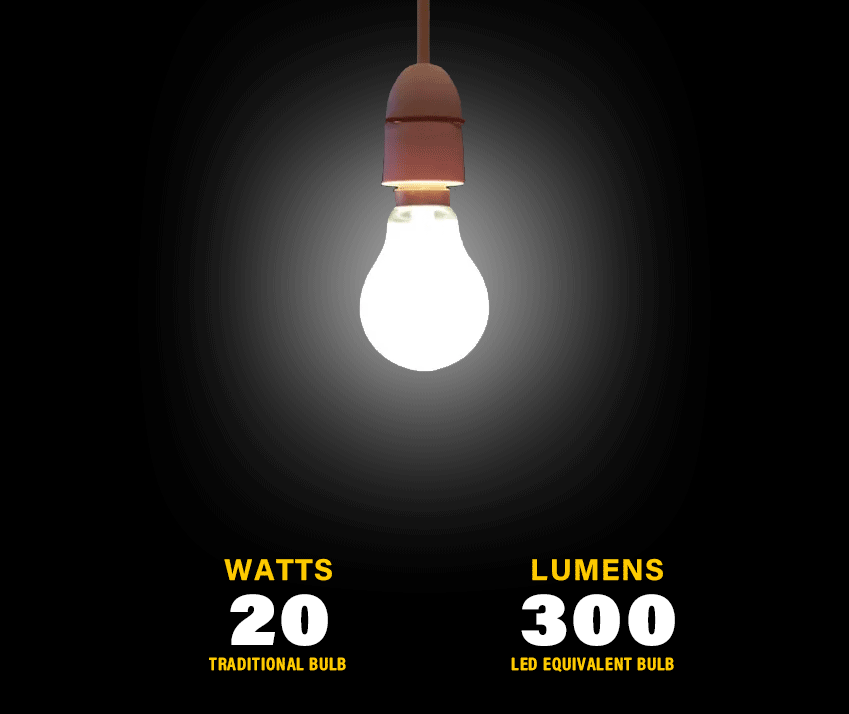
LUMENS is the measure the brightness of a bulb’s output or brightness. Higher lumens create a brighter light. On the packaging, the lumen rating is indicated by a number followed by “lm,” which is the abbreviation for lumens.
As you can see from this chart, an old-style 60-watt incandescent lamp produces 600 lumens. An LED on the other hand, can produce the same light output while consuming only 10 watts of power. LED lamps are not only cost-effective because of their consumption, but they also outlast most other lighting options. That being said, many fixtures will say Do Not Exceed 60 Watts somewhere on a sticker in the lamp – that’s for a traditional light bulb. With and LED bulb you could put a 13,000 lumen LED in the same socket which would give you the traditional equivalent of 100 Watts. Wow, more light with less power!
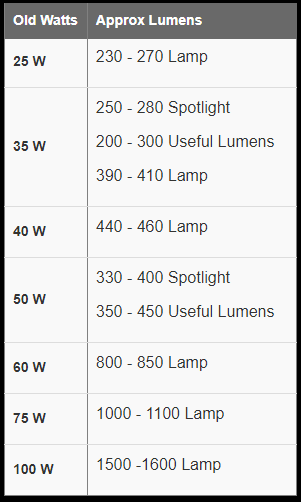
As for the typical home, bedrooms and living rooms need about 10-20 lumens per square foot, while kitchens and bathrooms need around 70-80 lumens per square foot. A 100 square foot bedroom, for example, will need about 1,000 lumens total, dispersed between all the light bulbs in the space. A 100 square foot bathroom, however, will need 7,000 lumens total, distributed between all the light bulbs.
KELVIN is “the base unit of thermodynamic temperature, equal in magnitude to the degree Celsius.” Scientific jargon aside, Kelvin is used in lighting to measure the color temperature of a particular light bulb. In short, the higher the Kelvin rating (expressed in K), the whiter the light will be.
Light bulb color temperature is represented in the unit of absolute temperature, Kelvin, noted by the symbol K. As a quick rule, the higher the Kelvin, the whiter the light. Household fixtures are commonly found in color temperatures on the Kelvin scale of 2700K (warm incandescent), 3000K (warm white halogen) and 3500K (household fluorescent).
Color temperatures higher than 3500K are typically used for commercial and hospital applications, as the light is bright and has a bluish daylight cast that can be harsh for home interiors; but task lighting may be useful at 4000K and above. When selecting new lighting for your home or project, be sure to take its color temperature into account to ensure the best outcome.
The right color temperature begins with the bulb. Use the Kelvin temperature color scale below to help identify the approximate hue certain bulbs will provide.
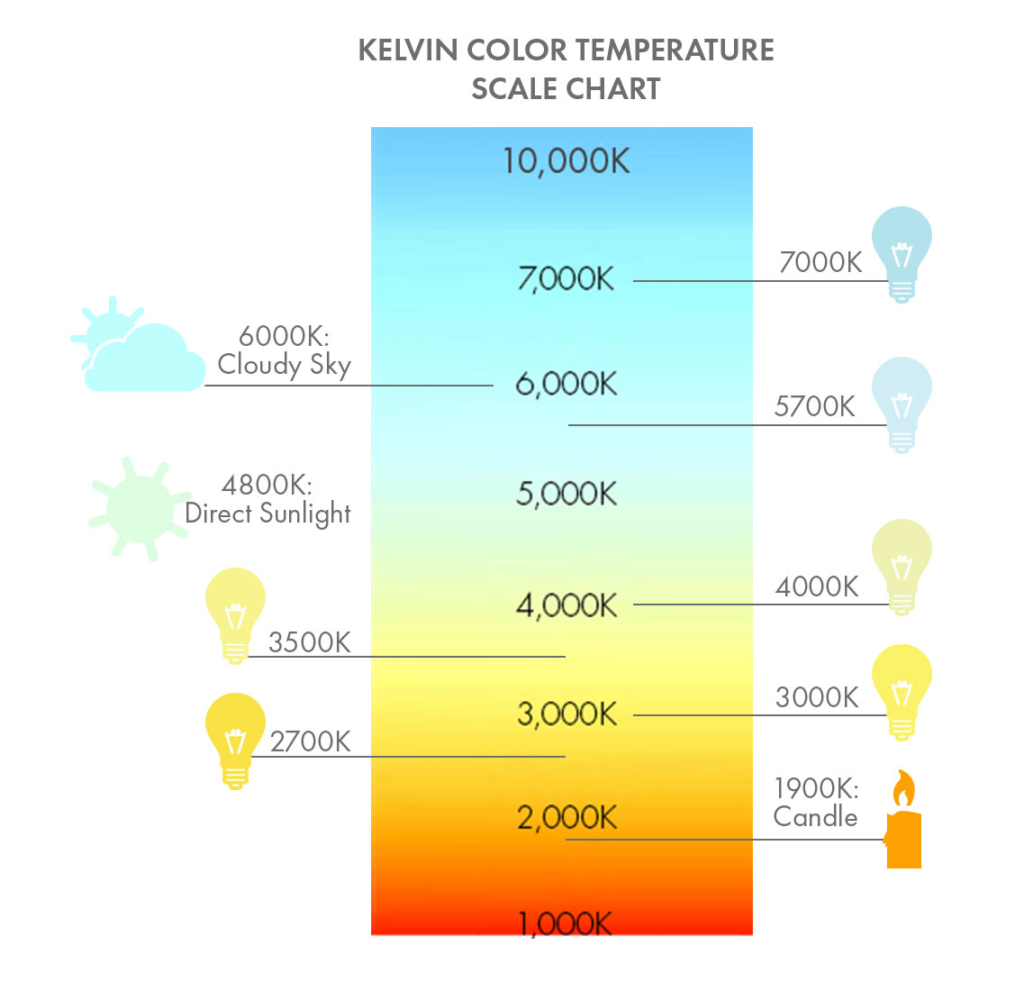
Warm light – 2700k – 3000k
Warm, yellowish light that creates a smooth, personal, intimate and relaxing feel. Very similar light to that of an incandescent light bulb. Warm temperature light is great for homes, libraries, hotels, retail stores, and restaurants.
Cool light – 3500k – 4100k
Cool light that creates a very friendly, inviting, non-threatening, neat, clean, and efficient feel. It is brighter than the incandescent cool white. Cool temperature light bulbs are great for executive offices, public reception areas, supermarkets, classrooms, and showrooms.
Daylight – 5000k – 6500k
Daylight is a bluish white light that resembles noon on a cloudless day. This light is great for reading and accent lighting. Bright light bulbs like this a great for jewelry stores, hospitals, beauty salons, galleries, and museums.
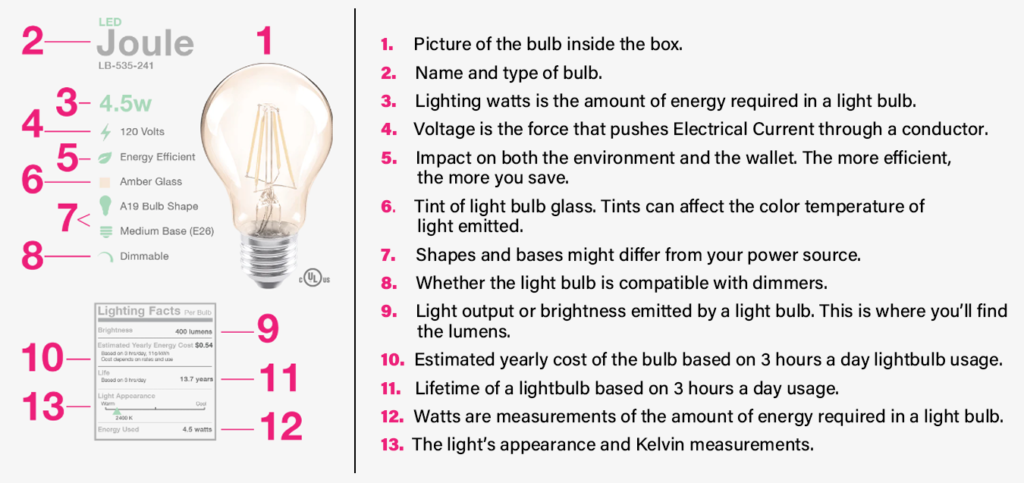
THE LIGHTING FACTS LABEL is modeled after the Nutrition Facts label on food packages and mandated by the Federal Trade Commission. The purpose of the label is to provide shoppers with all the information they need to buy the most energy efficient bulb to meet their needs, but sometimes all the information can be a bit confusing. The illustration above is a guide to help you understand the most common terms used in lighting along with specs, and certifications.
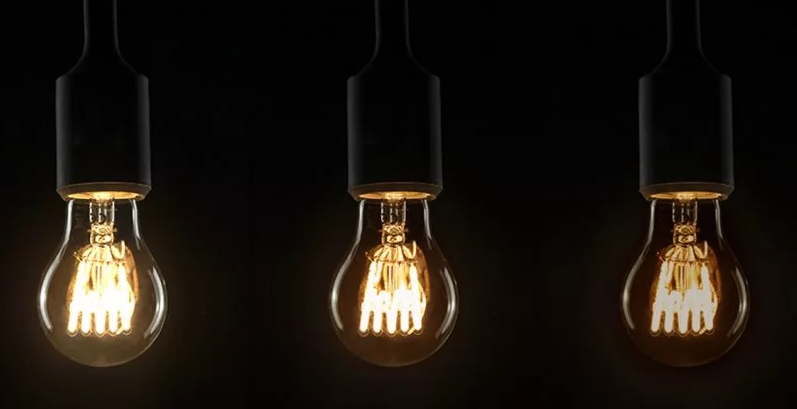
DIMMING OR NON-DIMMING? Determine the brightness and color temperature you want from your light bulbs. If you want to dim your light, you must have “dimmable” rated bulbs and have an LED dimming capable control installed. If not, the LED’s may not work or may begin flashing and damage the bulb.
Summing it all up, Replacement light bulbs must fit into the same bulb socket as the original bulbs.
A light bulb’s overall wattage (power consumption) should never exceed the wattage listed on the label of the light fixture socket.
With these tips, you should be able to choose the best replacement bulbs for your home. Use this guide the next time you are overwhelmed at the local big box hardware store – or contact us if you have any further questions and we’ll be happy to help. Congratulations! You just graduated from Lighting 201!

Peter D. Sawyer
Founder & CEO
Born in New York and now living in California, Peter is a dedicated and proud father of Xander – a true miracle of life. After spending 26 years as manager of Operations and Engineering for the CBS Television network, he launched OMG! Amazing in 2019 because he wanted to help people enjoy life in a smarter home.
Come Join Us
Join our Fixit Community and dive into conversations covering every aspect of home repair and improvement!
Current Articles
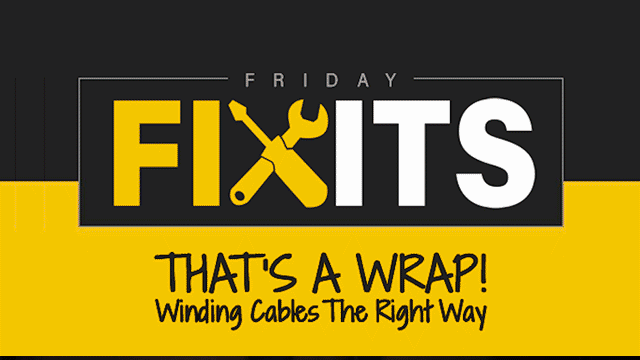
That’s A Wrap – Winding Cables the Right Way
Fixit Friday is published every Friday on our Facebook Page at https://www.facebook.com/profile.php?id=100088848193030

Where’s That Freakin’ Tool?
Fixit Friday is published every Friday on our Facebook Page at https://www.facebook.com/profile.php?id=100088848193030
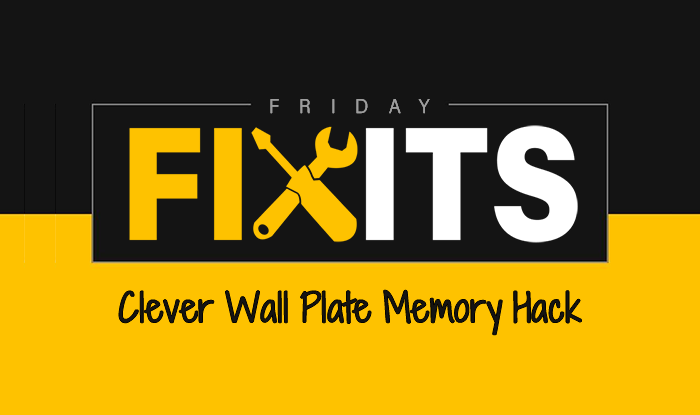
Clever Wall Plate Memory Hack
Fixit Friday is published every Friday on our Facebook Page at https://www.facebook.com/profile.php?id=100088848193030

Lighting 201 – The Ultimate Home Guide
Today Light Bulbs come in a vast variety of sizes, shapes, and colors which need different bases and other considerations. We’re here to guide you through the decision process with bulbs, fixtures, and lighting…this is Lighting 201.

Adjusting European Cabinet Hinges
Fixit Friday are plublished evert Friday on our Facebook Page at https://www.facebook.com/profile.php?id=100088848193030
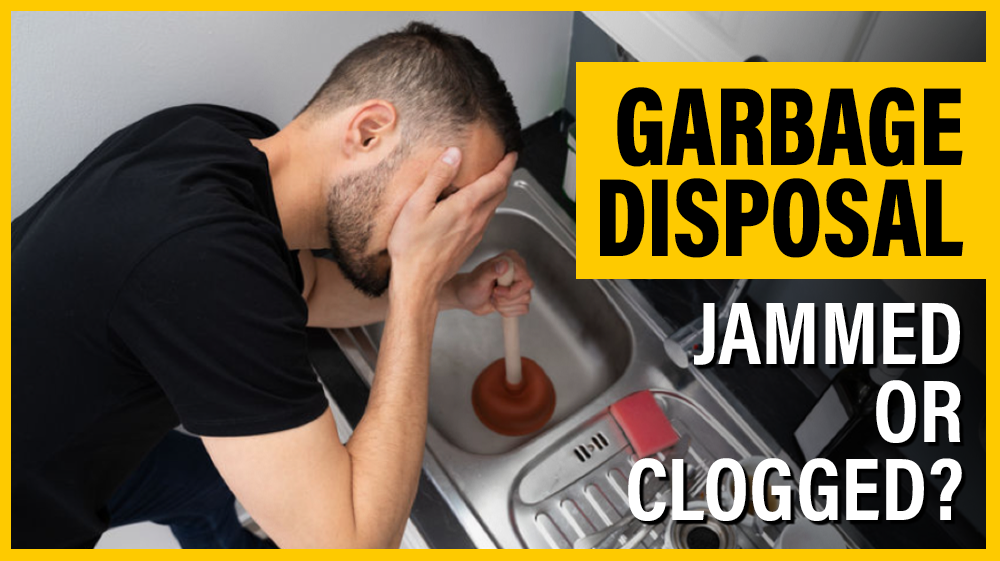
Fix That Garbage Disposal Clog
Why Is my garbage disposal not draining?More times than not, unclogging a garbage disposal is something you can knock out on your own. And the best part is you don’t have to be incredibly handy to pull off the task.
More Articles

That’s A Wrap – Winding Cables the Right Way
Fixit Friday is published every Friday on our Facebook Page at https://www.facebook.com/profile.php?id=100088848193030

Where’s That Freakin’ Tool?
Fixit Friday is published every Friday on our Facebook Page at https://www.facebook.com/profile.php?id=100088848193030

Clever Wall Plate Memory Hack
Fixit Friday is published every Friday on our Facebook Page at https://www.facebook.com/profile.php?id=100088848193030

Lighting 201 – The Ultimate Home Guide
Today Light Bulbs come in a vast variety of sizes, shapes, and colors which need different bases and other considerations. We’re here to guide you through the decision process with bulbs, fixtures, and lighting…this is Lighting 201.

Adjusting European Cabinet Hinges
Fixit Friday are plublished evert Friday on our Facebook Page at https://www.facebook.com/profile.php?id=100088848193030

Fix That Garbage Disposal Clog
Why Is my garbage disposal not draining?More times than not, unclogging a garbage disposal is something you can knock out on your own. And the best part is you don’t have to be incredibly handy to pull off the task.

Awesome Picture Hanging Hack
Fixit Friday are plublished evert Friday on our Facebook Page at https://www.facebook.com/profile.php?id=100088848193030
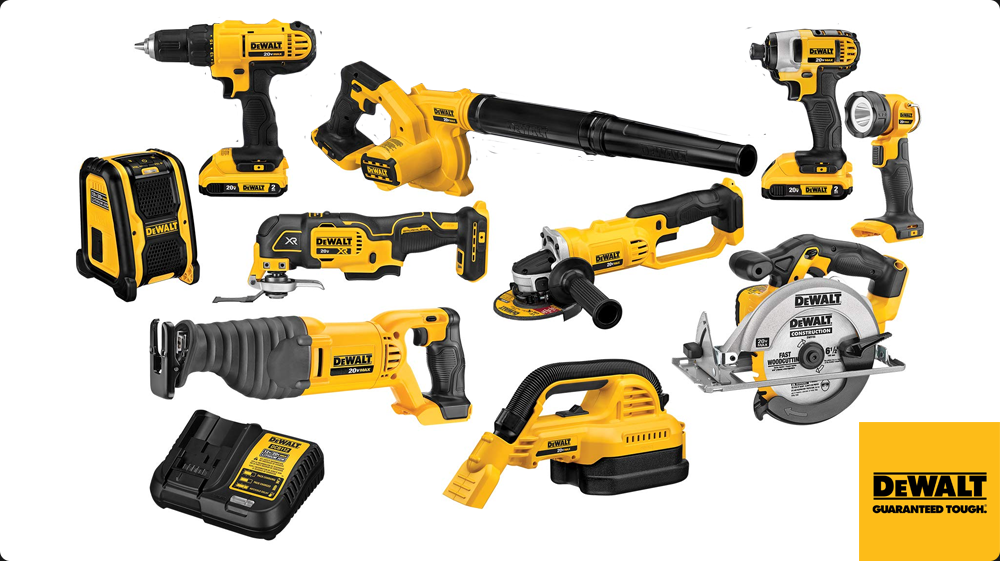
Dewalt Tools
DEWALT® designs and optimizes professional workhorse solutions – tools, accessories and service – to ensure confidence for the toughest jobsite conditions.
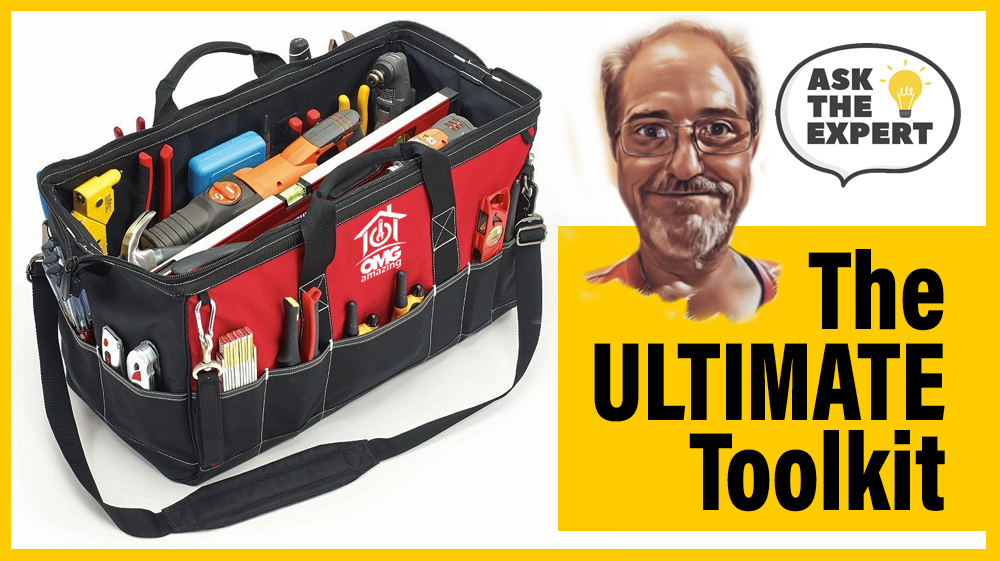
The Ultimate DIY Toolkit
If you decide to do repairs yourself, which can lead to savings over time, make sure you’re doing it with the right tools. We break down the different types of basic tools that you can use to complete each home maintenance and repair project. We’ve created this list of must-have tools as a starting point.
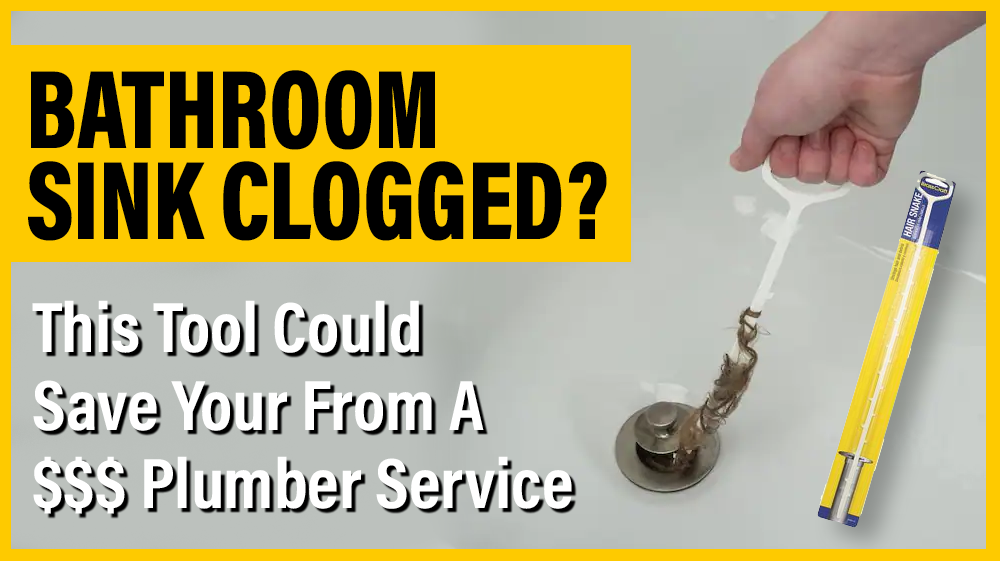
This Cheap Plumbing Tool Will Be Your New Best Friend
This inexpensive tool will be your new BFF and you Plumber’s worst enemy! It works wonders when your in a pinch and at this price, it’s worth having a few on hand near every sink. It also makes a good practical gift!
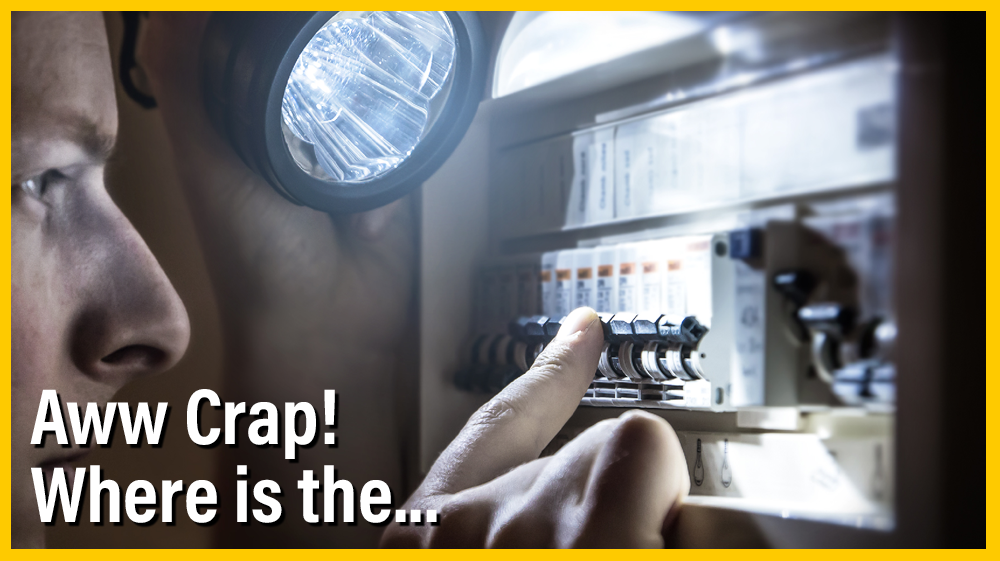
Six Things Every Homeowner Should Know!
Your home will have countless surprises for you over the years—and the right time to learn how to deal with them is not when you’re smack dab in the middle of a crisis. From some emergency preparedness to basic troubleshooting, these are the top six things everyone should know about their home. While it’s not a comprehensive guide, it’s a great place to start.

How to Reset a GFCI Outlet
A tripped GFCI outlet is often the cause of lighting and power issues and it is a simple fix. All is takes is a little troubleshooting knowhow.
More Endorsements

Dewalt Tools
DEWALT® designs and optimizes professional workhorse solutions – tools, accessories and service – to ensure confidence for the toughest jobsite conditions.
© 2023 - Fixit Academy (A Division of OMG! Amazing) All rights reserved

That’s A Wrap – Winding Cables the Right Way
Fixit Friday is published every Friday on our Facebook Page at https://www.facebook.com/profile.php?id=100088848193030

Where’s That Freakin’ Tool?
Fixit Friday is published every Friday on our Facebook Page at https://www.facebook.com/profile.php?id=100088848193030

Clever Wall Plate Memory Hack
Fixit Friday is published every Friday on our Facebook Page at https://www.facebook.com/profile.php?id=100088848193030

Lighting 201 – The Ultimate Home Guide
Today Light Bulbs come in a vast variety of sizes, shapes, and colors which need different bases and other considerations. We’re here to guide you through the decision process with bulbs, fixtures, and lighting…this is Lighting 201.

Adjusting European Cabinet Hinges
Fixit Friday are plublished evert Friday on our Facebook Page at https://www.facebook.com/profile.php?id=100088848193030

Fix That Garbage Disposal Clog
Why Is my garbage disposal not draining?More times than not, unclogging a garbage disposal is something you can knock out on your own. And the best part is you don’t have to be incredibly handy to pull off the task.

Awesome Picture Hanging Hack
Fixit Friday are plublished evert Friday on our Facebook Page at https://www.facebook.com/profile.php?id=100088848193030

Dewalt Tools
DEWALT® designs and optimizes professional workhorse solutions – tools, accessories and service – to ensure confidence for the toughest jobsite conditions.

The Ultimate DIY Toolkit
If you decide to do repairs yourself, which can lead to savings over time, make sure you’re doing it with the right tools. We break down the different types of basic tools that you can use to complete each home maintenance and repair project. We’ve created this list of must-have tools as a starting point.

This Cheap Plumbing Tool Will Be Your New Best Friend
This inexpensive tool will be your new BFF and you Plumber’s worst enemy! It works wonders when your in a pinch and at this price, it’s worth having a few on hand near every sink. It also makes a good practical gift!

Six Things Every Homeowner Should Know!
Your home will have countless surprises for you over the years—and the right time to learn how to deal with them is not when you’re smack dab in the middle of a crisis. From some emergency preparedness to basic troubleshooting, these are the top six things everyone should know about their home. While it’s not a comprehensive guide, it’s a great place to start.

How to Reset a GFCI Outlet
A tripped GFCI outlet is often the cause of lighting and power issues and it is a simple fix. All is takes is a little troubleshooting knowhow.




